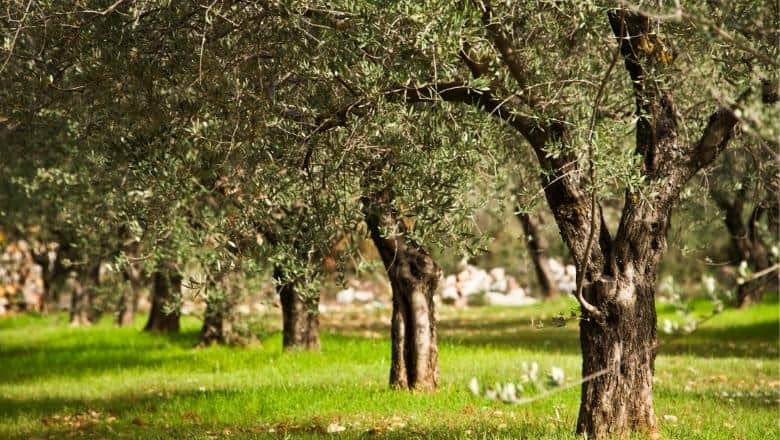Fruiting vs. Fruitless Olive Tree: Which One Is For You?
Olive Knowledge is a part of Amazon Associates. As an Amazon Associate, we earn from qualifying purchases. Read our Affiliate Disclosure to learn more.
While it’s possible to stop olive trees from bearing fruit, did you know that there are fruitless olive trees that naturally don’t grow any fruits?
In this post, I’ll show you the key differences between fruiting and fruitless olive trees and recommend which one you should get based on your needs.
Key Takeaways:
- Fruiting olive trees produce fruit annually, commonly used for oil and table olives, requiring regular care.
- Fruit can stain driveways and patios, necessitating more maintenance.
- Fruitless olive trees rarely bear fruit, are easier to care for, and are less prone to pests and diseases.
- Fruitless olive trees are ideal for landscaping. They occasionally produce small amounts of fruit unexpectedly.
Fruiting Olive Trees

Fruiting olive trees bear fruit every single year, and they’re the most commonly planted types of olive trees. If you come to any Mediterranean country, you’ll spot thousands of fruiting olive trees planted everywhere. That’s because olives grown on these trees are used for oil production, as well as the production of table olives.
Fruiting trees look amazing, with evergreen leaves and branched crowns. The growth rate is usually moderate, and they can grow up to 35 feet in height and similarly in width. There are some records that olive trees even grew to 50 feet high.
Even though olive trees are generally resistant, they still need a lot of care if you want to get plenty of olive fruit. Watering, mulching, fertilizing, and pruning are extremely important for olive trees to grow healthy fruits.
Most popular fruiting olive trees:
- Manzanilla
- Mission
- Picholine
- Arbequina
PROS
- You can earn some money
- You can produce your own olive oil or table olives
- They’re more beautiful, in my opinion
CONS
- Fallen fruit can stain your driveway and patio
- Require a bit more care than fruitless olive trees
Fruitless Olive Trees

Fruitless olive trees mostly won’t bear any fruit. Sometimes, fruitless olive trees will still bear some fruit, but it’s a rare occasion, and there won’t be many fruits. Just some here and there.
Fruitless olive trees look identical to fruiting olive trees, with evergreen leaves, branched crowns, and shallow roots. However, they usually tend to grow only up to 25-30 feet, with the same width. So, slightly less than fruiting olive trees.
Fruitless olive trees don’t require so much care since they don’t produce fruit, and you won’t have to worry about blooming, the quality of fruit, etc. Still, you should properly water, prune, and fertilize them for them to live longer.
Another important thing. Fruitless olive trees are usually more resistant to pests and diseases. Not because of their genes but because they don’t have fruit, which is proven to drive some additional insects and diseases.
There are no actual differences between fruiting and fruitless olive trees, except that the fruitless olive trees don’t bear olives.
Most popular fruitless olive trees:
- Majestic Beauty
- Bonita
- Wilsonii
- Swan Hill
PROS
- No fruits to litter your yard
- Slightly easier to care for
- Better for landscaping
- Great for planting in formal lines for flanking the driveway
CONS
- Sometimes, they’ll bear fruit unexpectedly (but in small amounts)
Which One Should You Plant?
I prefer planting fruiting olive trees, but that’s just my opinion and decision. I like to consume olives and produce olive oil. However, I’ll try to objectively show you which type of olive trees you should choose, based on your needs.
If you’re looking for information on olive trees’ prices and the best places to buy them, check the link.
Who Are Fruiting Olive Trees For?
Fruiting olive trees are for everyone who wants to plant an original olive tree that bears olives every year.
There are various reasons why you should consider planting a fruiting olive tree. If you want one of the following, plant fruiting olive trees:
- Produce table olives
- Produce olive oil
- Sell olive fruits
- A landscape tree that also bears fruits for an even better appearance and the look of your garden
Who Are Fruitless Olive Trees For?
Fruitless olive trees are mostly for people who want to improve the look of their garden or landscape.
So, if you want one of the following, consider planting fruitless olive trees:
- Keep olive tree inside
- Improve the design of your garden, especially for Italian-style landscapes
- You don’t want to mess with fruits falling and littering your yard and stain driveways and patios
- Lack of time for harvesting olives
- Don’t want to deal with so many pests and diseases
- You’re not allowed to plant fruiting olive trees
As you can see, there are some interesting reasons why you would want to plant fruitless olive trees instead of fruiting ones.
Also, many dwarf olive trees are usually fruitless. So, if you want some smaller type of olive tree that doesn’t bear fruits, make sure to pick dwarf fruitless olive trees. They’re perfect for in-home use, and they’re easier to maintain.
You’re The One Who Decides

In the end, you’re the one who can tell which type of olive tree is best for your needs. I gave you objective reasons to plant one or another, but you’ll have to choose. Both fruitless and fruiting olive trees are fantastic, and they both have their pros and cons.
In my opinion, the most important thing is the love for olive trees. If you like them, planting and caring for any type of olive tree won’t be a problem.
In the end, I just want to remind you that besides fruiting and fruitless olive trees, there are also fake olive trees, which are fantastic for all of you who want something beautiful without needing to care for it.
